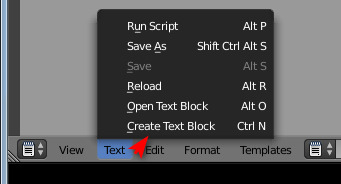Until today I’ve been a clueless newb when it comes to finding and loading/running the Python scripts that shipped with Blender 2.79. I knew Blender could run Python, but had no idea where to find that in the folders or the UI. Here’s what I learned with Blender 2.76, an older (2016) version needed to access many older free assets in .blend files. All this assumes that you don’t have a weird custom UI embedded in the .blend file you downloaded, which unfortunately is perfectly possible to set up in Blender’s utterly vile UI. In which case you may never find the following items.
Anyway, in Windows a set of free helper (‘template’) scripts are installed to…
C:\Program Files\Blender Foundation\Blender\2.76\scripts\templates_py\
Then in a sensibly set up normal Blender UI, you can find these at…
The Animation UI also has access to the same “Templates” menu-item, but it seems the other UI panels do not.
You can also paste your own .PY Python scripts in the above folder, and they will also show up in the UI via the same method. If you only have a few (you’re likely just being forced to use Blender to export from some free .blend files for DAZ or Poser use) then you probably want to prefix their name to get them to the top of the list (e.g. AAA-my_script.py).
Note that you don’t need to re-start Blender after pasting a new script in there (as you do with Poser), in order to see it on the list.
The above then appears to be the somewhat trickier-to-find equivalent of Poser’s Python scripts folder…
C:\Program Files\Smith Micro\Poser 11\Runtime\Python\poserScripts\ScriptsMenu
And of Poser’s rather more obvious Scripts drop-down…
The other and more ‘console-like’ temporary way to test an in-progress script in Blender is to go into Scripting or Animation, as seen above. But then…
1. Click on Text menu label.
2. “Create a Text Block” (Crtl + N).
3. You see an empty panel. Here you paste in the script from a plain text editor such as Notepad++.
4. Slide the infernal UI out the way, as it’s likely hiding the ‘Run Script’ button over on the right.
5. Run script (Alt + P). You can also do this by going back into the Text menu, where it is the top command.




